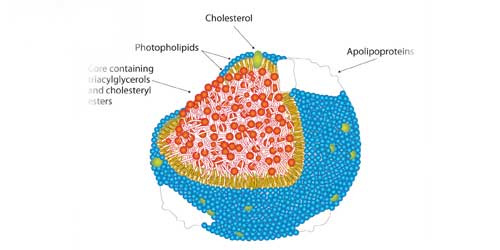Lipids are one of the four major groups of organic molecules; the other three being proteins, nucleic acids (DNA), and carbohydrates (sugars). Lipids are made up of the same elements as carbohydrates: carbon, hydrogen, and oxygen. However, lipids tend to contain many more hydrogen atoms than oxygen atoms.
Lipids include fats, steroids, phospholipids, and waxes. One main characteristic of lipids is that they do not dissolve in water. Lipids play an important role in living organisms. Some of their main functions include energy storage, hormones, and cell membranes.
Must Read: Cell Division and Cycle
Types of Lipids
Fats
Fats are composed of a glycerol molecule and three fatty acid molecules. Just like all lipids, fat molecules are made up of the elements carbon, hydrogen, and oxygen. Fat is used as energy storage in our bodies. Fats are needed by our bodies to be healthy. We couldn’t live without some fats in our diet. Most people need to get around 20%-30% of their food from fats. However, too much fat can be bad. It can cause you to be overweight and clog up your arteries.
Types of Fats
There are two main types of fats: saturated fats and unsaturated fats.
- Saturated Fats – Saturated fats are solids at room temperature. These fats tend to come from foods like red meat, cheese, and butter. Saturated fats are sometimes called “bad” fats because they have been known to cause higher cholesterol, clog arteries, and even increase the risk for some cancers.
- Unsaturated Fats – Unsaturated fats are liquids at room temperature. These fats tend to come from foods like nuts, vegetables, and fish. Unsaturated fats are considered much better for you than saturated fats and are sometimes called “good” fats.
Also Read: Important Facts about your Digestive System
Waxes
Waxes are similar to fats in their chemical makeup, however, they only have one long fatty acid chain. Waxes are soft and plastic at room temperatures. They are produced by animals and plants and are typically used for protection. Plants use waxes to help prevent water loss. Humans have wax in our ears to help protect our eardrums.
Steroids
Steroids are another major group of lipids. Steroids include cholesterol, chlorophyll, and hormones. Our bodies use cholesterol to make the hormones testosterone (male hormones) and estrogen (female hormones). Chlorophyll is used by plants to absorb light for photosynthesis.
Not all steroids are bad. Our bodies need steroids like cholesterol and cortisol to survive, so some steroids are good for us. There are also many steroids that doctors use to help sick people.
However, the type of steroids you hear about in sports, anabolic steroids, can be very bad for you. They can cause all sorts of damage to your body including strokes, kidney failure, blood clots, and liver damage.
Also Read: Chloroplasts – Unique Structures Found in Plant Cells
Phospholipids
Phospholipids make up the fourth major group of lipids. They are very similar to fats in their chemical makeup. Phospholipids are one of the main structural components of all cell membranes.
Interesting Facts about Lipids
- When a compound is not water soluble it is called “hydrophobic.”
- Honeybees use wax to make their honeycombs.
- Waxes are used in all sorts of everyday applications including chewing gum, polishes, and candles.
- Fats help us to dissolve and store some important vitamins including A, D, E, and K.
- Cortisol is a type of steroid that our bodies use to regulate energy and fight off diseases.
Don’t Miss:



